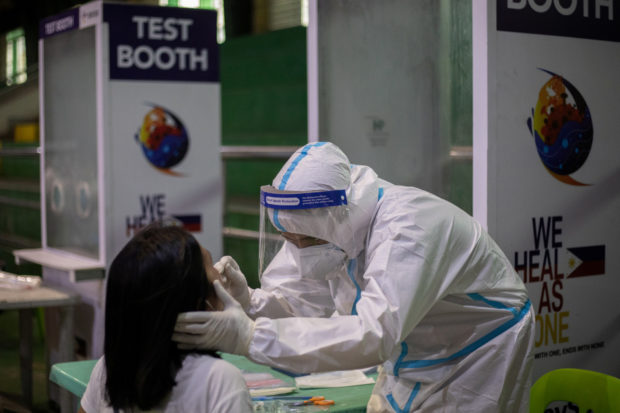
FILE PHOTO: A health worker conducts a new coronavirus disease (COVID-19) swab testing at a gymnasium in Navotas City, Metro Manila, on Aug. 7, 2020. (Photo ELOISA LOPEZ / REUTERS)
MANILA, Philippines — Activists and media advocates on Tuesday said the decision of the Department of Health (DOH) to stop posting daily COVID-19 updates on its social media accounts starting Jan. 1 was a blow to transparency during a health crisis exacerbated by the emergence of the Omicron variant in the Philippines.
Bayan Secretary General Renato Reyes and University of the Philippines journalism professor Danilo Arao urged the DOH to reconsider its decision, with the latter saying that the daily case bulletin was “necessary for people to cross-check news reports.”
The DOH had announced that it would no longer issue social media updates as part of its efforts to “streamline public communication.” Instead, the updates will be reflected every 4 p.m. on the official tracker posted on its website.
The Philippines recorded its fourth confirmed Omicron case in a 38-year-old female traveler who arrived at Ninoy Aquino International Airport from the United States on Dec. 10 on Philippine Airlines’ flight PR 127.
The woman’s 37-year-old Filipino husband has since tested positive for the coronavirus and is now in isolation, Health Undersecretary Maria Rosario Vergeire said in a message to reporters on Tuesday.
Vergeire said specimen samples from the Filipino husband would be sent to the Philippine Genome Center (PGC) for sequencing to determine what COVID-19 variant had infected him.
What ‘streamlining’?
Arao said the DOH “should explain what it means by streamlining its operations, particularly in identifying other activities [it] deems more important than public information.”
“Much as we hope that the media will still continue with daily case updates, the government should do its own part in giving vital information to the public.”
Echoing Arao’s sentiments, Reyes wondered why the DOH would want to streamline communications when “there is great demand for daily updates.”
He also wondered whether the publication of daily updates was being hampered by budgetary or manpower issues, and called on the DOH to address the matter.
“In a time when the threat of a new surge remains due to the movement of people during the holidays and the arrival of the Omicron variant, updated public information from DOH is all the more needed,” Reyes said. “The department should [neither] scrimp on this nor lessen their frequency.”
The DOH daily case updates include information on new cases, recoveries, deaths, active cases, as well as bed occupancies in ICU, isolation and wards in hospitals nationwide. Likewise included are relevant notes explaining the day’s numbers, such as whether there were labs unable to report.
These updates are not currently part of the DOH’s online tracker, noted Jason Haw, an epidemiology expert from Johns Hopkins University and part of the team that helped set up the tracker in 2020.
“I feel bad for media outlets who rely on the case bulletin because right now, one has to dig through the tracker data drop to get the information needed,” Haw said.
In isolation
Vergeire said the couple who arrived together from the United States were tested on the same day and later isolated upon the release of the woman’s positive result.
They were discharged asymptomatic on Dec. 24 after completing their 10-day isolation. But with the wife testing positive for Omicron, the husband was returned to isolation.
“We have already traced [her] contacts. Her family, for one. Her husband turned positive also. He is currently in the isolation facility,” Vergeire said, adding that the couple’s close contacts at home had all been isolated and would be tested based on existing protocols.
Earlier, Vergeire said the wife, who was sent home to complete her isolation before the PGC released the result showing she was positive for Omicron, was scheduled for another swab test on Tuesday.
She said the woman was fully inoculated with Moderna vaccine.
Vergeire said the DOH had a copy of the flight manifest, and “we are just trying to determine who among these passengers were within close contact” with the couple.
She said the “epidemiological definition of close contacts in terms of riding a plane” would be applied: “four seats in front, four seats beside, and four seats at the back.”
Low risk
In its latest report, the independent OCTA Research group said Metro Manila was now at low risk for COVID-19, with five local government units (LGUs) — Pateros, Valenzuela, Quezon City, Pasig, and Taguig — classified as at very low risk.
Manila and San Juan are at moderate risk due to an increase in the reproduction number, or the number of people that a COVID-positive person can infect.
The 10 other LGUs—Caloocan, Malabon, Marikina, Parañaque, Muntinlupa, Navotas, Pasay, Mandaluyong, Makati and Las Piñas—are at low risk, according to OCTA.
It said the average number of new COVID cases in the National Capital Region rose to 126 on Dec 21-27, from 77 on Dec. 14-20.
The DOH said in a case bulletin that the COVID positivity rate on Tuesday was recorded at 2.6 percent, up from 2.2 percent recorded on Monday but still within the benchmark 5 percent set by the World Health Organization.
The latest positivity rate was based on 18,122 persons who were tested on Sunday.
The Philippines has logged 421 new infections, bringing the total to 2,839,111 since the start of the pandemic. The number does not include data from two labs that did not operate on Dec. 26, and 16 other labs that failed to submit data to the COVID-19 Document Repository System.Of the 421 new infections, 410 cases, or 97 percent, were recorded in the last two weeks, with Metro Manila accounting for the biggest number with 170, followed by Calabarzon (Cavite, Laguna, Batangas, Rizal and Quezon) and Central Luzon.